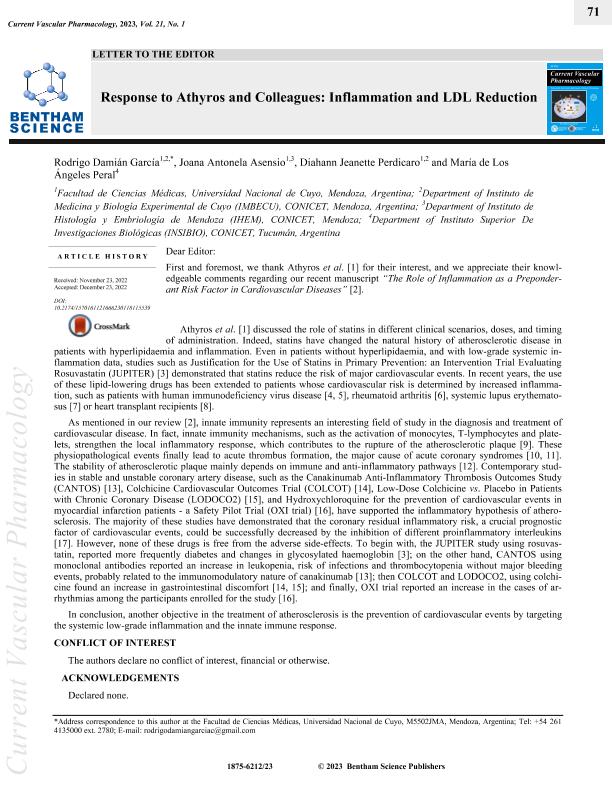Mostrar el registro sencillo del ítem
dc.contributor.author
García, Rodrigo Damián

dc.contributor.author
Asensio, Joana Antonela

dc.contributor.author
Perdicaro, Diahann Jeanette

dc.contributor.author
Peral, Maria de Los Angeles

dc.date.available
2024-04-19T15:55:25Z
dc.date.issued
2023-01
dc.identifier.citation
García, Rodrigo Damián; Asensio, Joana Antonela; Perdicaro, Diahann Jeanette; Peral, Maria de Los Angeles; Response to Athyros and Colleagues: Inflammation and LDL Reduction; Bentham Science Publishers; Current Vascular Pharmacology; 21; 1; 1-2023; 71-72
dc.identifier.issn
1570-1611
dc.identifier.uri
http://hdl.handle.net/11336/233621
dc.description.abstract
Atyros has discussed the role of statins in different clinical scenarios, doses, and timing of application. In response to your interesting observations, we would like to comment that statins have indeed changed the natural history of atherosclerotic disease in patients with hyperlipaemia and inflammation. Even in patients without hyperlipidemia, and with low-grade systemic inflammation data, studies such as JUPITER [1] demonstrated that statins reduce the risk of major cardiovascular events. In recent years, the use of these lipid-lowering drugs has been extended to patients whose cardiovascular risk is determined by an increased baseline inflammatory rate, such as patients infected with human immunodeficiency virus [2, 3], rheumatoid arthritis [4], systemic lupus erythematosus [5], and heart transplant recipients [6]. As mentioned in our review article [7], innate immunity represents an interesting field of study in the diagnosis and treatment of cardiovascular disease. In fact, innate immunity mechanisms, such as activation of monocytes, T-lymphocytes and platelets, strengthen the local inflammatory response, which contribute to the rupture of the atherosclerotic plaque [8]. These physiopathological events finally lead to acute thrombus formation, the major cause of acute coronary syndromes [9, 10]. The stability of atherosclerotic plaque mainly depends on immune and antiinflammatory pathways [11]. Contemporary studies in stable and unstable coronary artery disease, such as the CANTOS study [12], the COLCOT [13], the LODOCO2 [14], and the OXI trial [15], have supported the inflammatory hypothesis of atherosclerosis. The majority of these studies have demonstrated that the coronary residual inflammatory risk, a crucial prognostic factor of cardiovascular events, could be successfully decreased by inhibition of different proinflammatory interleukins [16]. In conclusion, the horizon in the treatment for atherosclerosis is the prevention of cardiovascular events by targeting the systemic low-grade inflammation and the innate immune response.
dc.format
application/pdf
dc.language.iso
eng
dc.publisher
Bentham Science Publishers

dc.rights
info:eu-repo/semantics/openAccess
dc.rights.uri
https://creativecommons.org/licenses/by/2.5/ar/
dc.subject
INFLAMMATION
dc.subject
CARDIOVASCULAR DISEASES
dc.subject
ATYROS
dc.subject.classification
Sistemas Cardíaco y Cardiovascular

dc.subject.classification
Medicina Clínica

dc.subject.classification
CIENCIAS MÉDICAS Y DE LA SALUD

dc.title
Response to Athyros and Colleagues: Inflammation and LDL Reduction
dc.type
info:eu-repo/semantics/article
dc.type
info:ar-repo/semantics/artículo
dc.type
info:eu-repo/semantics/publishedVersion
dc.date.updated
2024-03-13T13:57:36Z
dc.identifier.eissn
1875-6212
dc.journal.volume
21
dc.journal.number
1
dc.journal.pagination
71-72
dc.journal.pais
Estados Unidos

dc.journal.ciudad
Oak Park
dc.description.fil
Fil: García, Rodrigo Damián. Consejo Nacional de Investigaciones Científicas y Técnicas. Centro Científico Tecnológico Conicet - Mendoza. Instituto de Medicina y Biología Experimental de Cuyo; Argentina. Universidad Nacional de Cuyo. Facultad de Ciencias Médicas; Argentina
dc.description.fil
Fil: Asensio, Joana Antonela. Consejo Nacional de Investigaciones Científicas y Técnicas. Centro Científico Tecnológico Conicet - Mendoza. Instituto de Histología y Embriología de Mendoza Dr. Mario H. Burgos. Universidad Nacional de Cuyo. Facultad de Ciencias Médicas. Instituto de Histología y Embriología de Mendoza Dr. Mario H. Burgos; Argentina. Universidad Nacional de Cuyo. Facultad de Ciencias Médicas; Argentina
dc.description.fil
Fil: Perdicaro, Diahann Jeanette. Consejo Nacional de Investigaciones Científicas y Técnicas. Centro Científico Tecnológico Conicet - Mendoza. Instituto de Medicina y Biología Experimental de Cuyo; Argentina. Universidad Nacional de Cuyo. Facultad de Ciencias Médicas; Argentina
dc.description.fil
Fil: Peral, Maria de Los Angeles. Consejo Nacional de Investigaciones Científicas y Técnicas. Centro Científico Tecnológico Conicet - Tucumán. Instituto Superior de Investigaciones Biológicas. Universidad Nacional de Tucumán. Instituto Superior de Investigaciones Biológicas; Argentina
dc.journal.title
Current Vascular Pharmacology

dc.relation.alternativeid
info:eu-repo/semantics/altIdentifier/url/https://www.eurekaselect.com/article/128907
dc.relation.alternativeid
info:eu-repo/semantics/altIdentifier/doi/http://dx.doi.org/10.2174/1570161121666230118115539
Archivos asociados
